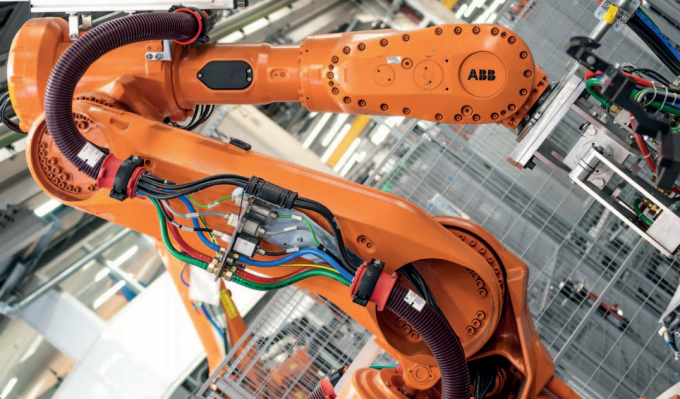

Product Details
Place of Origin: Hefei Anhui China
Brand Name: FeiChun™
Certification: CSA & UL
Model Number: Robotic Flexible Welding Cables
Payment & Shipping Terms
Minimum Order Quantity: 800 M
Price: 8-10 USD per meter, price varies according to specifications
Packaging Details: Cable Reels or Packaging Bags
Delivery Time: 15-30 Days
Payment Terms: T/T or Western Union
Supply Ability: 12,000 meters per week
Features: |
Easy Installation |
Outer Diameter: |
2.5-20mm |
Insulation Material: |
Polyurethane |
Flexural Life: |
Over 15 Million |
Flammability Rating: |
Combustible |
Color: |
Brown, Blue, Black, Red |
Model: |
TRVV |
Number Of Conductors: |
2-50 |
Jacket: |
Special PVC |
Flexibility: |
High |
Features: |
Easy Installation |
Outer Diameter: |
2.5-20mm |
Insulation Material: |
Polyurethane |
Flexural Life: |
Over 15 Million |
Flammability Rating: |
Combustible |
Color: |
Brown, Blue, Black, Red |
Model: |
TRVV |
Number Of Conductors: |
2-50 |
Jacket: |
Special PVC |
Flexibility: |
High |
In today’s world of robotic automation, dynamic robotic flexible welding cables play an essential role in ensuring the seamless and efficient operation of industrial robots.

Whether it’s for automated welding in the automotive sector or high-precision work in aerospace, these cables are designed to endure the demanding conditions of robot applications.
In this article, we will explore the unique features, applications, and benefits of UL Recognized and CSA Approved dynamic robot cables, highlighting why they are the go-to choice for industries that rely on precision, durability, and safety.
When it comes to industrial robots, especially in the welding sector, the type of cable you use can significantly impact performance.
Dynamic robotic welding cables are built to handle constant movement, bending, and flexing that robots undergo during their tasks. Standard cables simply cannot withstand the intense wear and tear caused by the continuous motion in robotic arms.
Here’s why high-flex robotic cables are critical in welding applications:
Durability and Flexibility: These cables are made to last through extreme bending and stretching, ensuring your robotic systems run smoothly.
High Heat and Chemical Resistance: Designed to withstand high temperatures, sparks from welding, and exposure to chemicals.
Longevity: These cables can operate reliably for years in harsh environments, reducing downtime and maintenance costs.
Safety Standards Compliance: UL Listed and CSA Certified cables meet strict North American safety standards, ensuring peace of mind.
Dynamic robotic flexible welding cables offer several advantages over standard cables. Below are some key features that make them stand out:
| Feature | Description |
|---|---|
| High Flexibility | Capable of withstanding continuous bending, torsion, and twisting without breaking. |
| Heat Resistance | Ideal for high-temperature welding environments. |
| Oil and Chemical Resistance | Designed to resist oils, chemicals, and other corrosive materials that are common in industrial settings. |
| Abrasion Resistance | Built to endure tough operating conditions, such as rough handling and friction in robotic arms. |
| UL Recognized | Approved for safety and performance in North America, ensuring they meet strict safety standards. |
| CSA Approved | Complies with Canadian standards for use in industrial applications. |
| Customizable Options | Available in custom lengths and designs to suit specific robot models and industrial applications. |
Flexible welding cables are used across various industries where precision welding is needed. Here are a few applications where dynamic robotic cables shine:
In the automotive industry, robots handle tasks such as welding, assembly, and painting. High flex welding cables for robotics ensure that these systems can operate continuously, improving productivity and safety in manufacturing plants.
Robotic welding in the aerospace industry requires precision and reliability. High-temperature, high-flex robot welding cables for welding applications are necessary to ensure that these systems perform under the most challenging conditions.
In metal fabrication, robots are used for cutting, welding, and assembling metal structures. The oil and chemical-resistant, UL-listed robotic cables help to ensure the robots function properly even in environments with heavy exposure to lubricants and chemicals.
In industrial automation, where robots operate 24/7, having torsion-resistant, CSA-approved dynamic robot cables ensures that the robots can continue to function without any issues, providing consistent output without costly downtimes.
Using the right cable can make a world of difference in how your robot performs and how long it lasts. Here are some of the benefits of using high-flex robotic cables for welding:
Reduced Wear and Tear: The flexible robot cables for automation reduce strain on the robot’s components, extending the life of both the cables and the machine.
Increased Safety: UL Listed and CSA Certified welding cables are tested for safety, reducing the risk of fire, electrical hazards, or malfunctions.
Cost-Efficiency: Durable cables mean fewer replacements and repairs, lowering the overall cost of ownership.
Custom Solutions: Manufacturers offer custom-made flexible welding cables for specific robots, ensuring a perfect fit for your unique setup.
Environmental Resistance: These cables are built to resist chemicals, oils, and harsh environmental factors, providing reliability in various settings.
Robotic systems, especially in welding, must operate in environments where high heat, chemicals, and physical stress are the norm.
Dynamic robot cables need to be robust enough to withstand such conditions. Here’s a breakdown of how these cables perform in different environments:
| Environmental Factor | Cable Performance |
|---|---|
| High Heat | Resistant to extreme temperatures, suitable for robotic welding cables operating near furnaces or in high-temperature zones. |
| Chemicals and Oils | The outer insulation of oil and chemical-resistant UL-listed robotic cables prevents damage from spills and splashes. |
| Abrasion | Cables are built with tough outer layers to resist wear and tear from constant movement and rough handling. |
| Outdoor Use | Certain models are designed for chemical-resistant cables for outdoor use, with UV and moisture resistance. |
Selecting the correct flexible welding cables for your robotics setup depends on several factors, including your operating environment, cable movement, and exposure to chemicals or oils.
Here are a few things to consider when choosing high flex robot welding cables for robot applications:
Flexibility: Look for high-flexibility cables if your robotic system performs continuous movements, such as twisting and bending.
Temperature Resistance: Ensure that your cables can withstand the operating temperatures of your facility.
Chemical Resistance: For robot applications in chemical plants or environments with oil exposure, ensure that the cables are resistant to corrosive materials.
Safety Compliance: Always select UL Recognized and CSA Approved cables to ensure they meet local safety regulations.
Let’s consider a case study where an automotive manufacturer implemented dynamic robotic welding cables in their assembly line. The plant required high flex welding cables for robotic welding, which needed to withstand high temperatures, constant movement, and exposure to oils.
By choosing torsion-resistant, CSA-approved dynamic robot cables, the company was able to reduce cable failure rates by 30%, saving them thousands of dollars in maintenance costs.
Additionally, the oil and chemical-resistant UL-listed robotic cables provided the durability needed to handle harsh conditions without compromising performance.
What makes dynamic robotic welding cables different from standard cables?
Dynamic robotic cables are designed to handle constant movement, bending, and torsion, unlike standard cables that can break under such conditions. They are also built to withstand high temperatures and chemical exposure.
Are these cables safe to use in North America?
Yes, UL Recognized and CSA Approved cables meet the safety standards for use in North American industries, ensuring they are safe and reliable.
Can these cables be customized for specific applications?
Yes, many manufacturers offer custom-made flexible welding cables that can be tailored to meet the specific needs of your robotic systems.
Investing in dynamic robotic flexible welding cables is essential for any company that relies on industrial robots, especially for demanding applications like welding. With their ability to withstand constant motion, high temperatures, and harsh chemicals, these cables are a key component in maximizing the performance and lifespan of robotic systems.
Choosing UL Listed and CSA Certified cables ensures that you meet all safety standards, giving you peace of mind as you focus on your production goals.
Whether you're looking for high flex robotic cables for automation or custom solutions for your robotic system, these cables offer durability, flexibility, and safety, making them the best choice for any robotic welding application.



Note: This is just part of the standard parameters of our products. Please contact our Engineer if you need more. And the information contained within this webpage is for guidance only and is subject to change without notice or liability. All dimensions and specifications are nominal and are subject to normal manufacturing tolerances. All pictures shown are for illustration purposes only. The actual product may vary. All the information is provided in good faith and is believed to be correct at the time of publication.